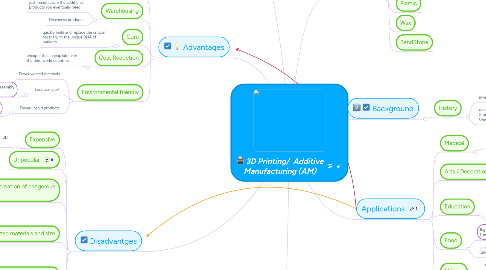
1. Advantages
1.1. More jobs
1.1.1. more technicians are needed for maintenance
1.2. Warehousing
1.2.1. just manufacture the additional products you eventually need
1.2.2. No excess products
1.3. Cure
1.3.1. quickly build and replace the critical organs with the unique DNA of patients
1.4. Cost Reduction
1.4.1. cheaper than cheap labour in the third world countries
1.5. Environmental friendly
1.5.1. Fewer wasted materials
1.5.2. Less transport
1.5.2.1. Local production and assembly become possible
1.5.3. Fewer unsold products
1.5.3.1. Make the products that the company wants
2. Disadvantges
2.1. Expensive
2.1.1. Initial set-up cost of 3D printers
2.2. Unpopular
2.3. Easy creation of dangerous items
2.3.1. little or no oversight
2.3.1.1. guns
2.3.1.2. knives
2.3.2. guns control loopholes
2.4. Limited materials and size
2.4.1. Few materials can be used.
2.4.2. 3D products with mixed materials and technology are still under development
2.4.2.1. E.g. circuit boards
2.4.3. too large like houses and buildings
2.5. Not environmental friendly
2.5.1. Creation of more useless stuff as quick and easy production of item
2.5.2. heavy reliance on plastics
2.6. Unemployment
2.6.1. Replacement of labours in factories
2.7. Bioprinting ethics and regulations
2.8. Intellectual property issues
3. Impact
3.1. Quicker and more convenient in prototyping and manufaturing
3.2. breakthrough in the medical industry
4. Mechanism
4.1. Modeling
4.2. Printing
4.2.1. 1. Read every slices / 2D image
4.2.2. 2. Blend each layer to have no any visible sign of layers
4.3. Finishing
5. Applications
5.1. Medical
5.1.1. manufature of human parts or organs
5.2. Arts / Decoration
5.2.1. new types of morden arts
5.2.2. toys
5.2.3. dining utensils
5.3. Education
5.3.1. New changes of paradigm of how the new generation to see the current innovations and manufactures
5.4. Food
5.4.1. E.g. NASA - replace the freeze-dried food
5.4.2. In liquid and powder form (under development)
5.5. Military
5.5.1. Guns
5.5.2. Bullets
6. Materials
6.1. ceramics
6.2. metals
6.2.1. Gold
6.2.2. Bronze
6.2.3. steel
6.2.4. platinum
6.3. Plastic
6.4. Wax
6.5. SandStone
7. Background
7.1. History
7.1.1. invented in 1984 by Charles W. Hull
7.1.2. developed in mid-1990s by Stanford and Carnegie Mellon University

